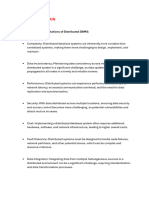0% found this document useful (0 votes)
8 views2 pagesWireless Technologies and Programming
The document outlines the differences between centralized and decentralized ledger systems, highlighting their respective advantages and disadvantages. Centralized systems offer efficiency and security but are prone to single points of failure, while decentralized systems provide transparency and fault tolerance but face scalability and regulatory challenges. It also discusses blockchain immutability and the 51% rule, explaining how control over the majority of a network's power can compromise the integrity of the blockchain.
Uploaded by
theemugaCopyright
© © All Rights Reserved
We take content rights seriously. If you suspect this is your content, claim it here.
Available Formats
Download as PDF, TXT or read online on Scribd
0% found this document useful (0 votes)
8 views2 pagesWireless Technologies and Programming
The document outlines the differences between centralized and decentralized ledger systems, highlighting their respective advantages and disadvantages. Centralized systems offer efficiency and security but are prone to single points of failure, while decentralized systems provide transparency and fault tolerance but face scalability and regulatory challenges. It also discusses blockchain immutability and the 51% rule, explaining how control over the majority of a network's power can compromise the integrity of the blockchain.
Uploaded by
theemugaCopyright
© © All Rights Reserved
We take content rights seriously. If you suspect this is your content, claim it here.
Available Formats
Download as PDF, TXT or read online on Scribd
/ 2





















































































